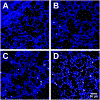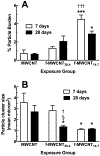Lung deposition patterns of MWCNT vary with degree of carboxylation
- PMID: 31111787
- PMCID: PMC6530805
- DOI: 10.1080/17435390.2018.1530392
Lung deposition patterns of MWCNT vary with degree of carboxylation
Abstract
Functionalization of multi-walled carbon nanotubes (MWCNT) is known to affect the biological response (e.g. toxicity, inflammation) in vitro and in vivo. However, the reasons for these changes in vivo are not well described. This study examined the degree of MWCNT functionalization with regard to in vivo mouse lung distribution, particle retention, and resulting pathology. A commercially available MWCNT (source MWCNT) was functionalized (f-MWCNT) by systematically varying the degree of carboxylation on the particle's surface. Following a pilot study using seven variants, two f-MWCNT variants were chosen and for lung pathology and particle distribution using oropharyngeal aspiration administration of MWCNT in Balb/c mice. Particle distribution in the lung was examined at 7 and 28 days post-instillation by bright-field microscopy, CytoViva hyperspectral dark-field imaging, and Stimulated Raman Scattering (SRS) microscopy. Examination of the lung tissue by bright-field microscopy showed some acute inflammation for all MWCNT that was highest with source MWCNT. Hyperspectral imaging and SRS were employed to assess the changes in particle deposition and retention. Highly functionalized MWCNT had a higher lung burden and were more disperse. They also appeared to be associated more with epithelial cells compared to the source and less functionalized MWCNT that were mostly interacting with alveolar macrophages (AM). These results showing a slightly reduced pathology despite the extended deposition have implications for the engineering of safer MWCNT and may establish a practical use as a targeted delivery system.
Keywords: MWCNT; Stimulated Raman Scatter; carboxylation; functionalization; macrophage.
Conflict of interest statement
Competing Interests
The authors declare no conflicts of interest.
Figures










Similar articles
-
Mouse pulmonary dose- and time course-responses induced by exposure to nitrogen-doped multi-walled carbon nanotubes.Inhal Toxicol. 2020 Jan;32(1):24-38. doi: 10.1080/08958378.2020.1723746. Epub 2020 Feb 7. Inhal Toxicol. 2020. PMID: 32028803 Free PMC article.
-
The Effects of Varying Degree of MWCNT Carboxylation on Bioactivity in Various In Vivo and In Vitro Exposure Models.Int J Mol Sci. 2018 Jan 25;19(2):354. doi: 10.3390/ijms19020354. Int J Mol Sci. 2018. PMID: 29370073 Free PMC article.
-
Distribution and fibrotic response following inhalation exposure to multi-walled carbon nanotubes.Part Fibre Toxicol. 2013 Jul 30;10:33. doi: 10.1186/1743-8977-10-33. Part Fibre Toxicol. 2013. PMID: 23895460 Free PMC article.
-
Lung deposition and toxicological responses evoked by multi-walled carbon nanotubes dispersed in a synthetic lung surfactant in the mouse.Arch Toxicol. 2012 Jan;86(1):137-49. doi: 10.1007/s00204-011-0741-y. Epub 2011 Jul 30. Arch Toxicol. 2012. PMID: 21805258
-
Multi-walled carbon nanotube physicochemical properties predict pulmonary inflammation and genotoxicity.Nanotoxicology. 2016 Nov;10(9):1263-75. doi: 10.1080/17435390.2016.1202351. Epub 2016 Jul 7. Nanotoxicology. 2016. PMID: 27323647 Free PMC article.
Cited by
-
Respiratory and systemic impacts following MWCNT inhalation in B6C3F1/N mice.Part Fibre Toxicol. 2021 Mar 26;18(1):16. doi: 10.1186/s12989-021-00408-z. Part Fibre Toxicol. 2021. PMID: 33771183 Free PMC article.
-
Simulated Gastric Digestion and In Vivo Intestinal Uptake of Orally Administered CuO Nanoparticles and TiO2 E171 in Male and Female Rat Pups.Nanomaterials (Basel). 2021 Jun 4;11(6):1487. doi: 10.3390/nano11061487. Nanomaterials (Basel). 2021. PMID: 34199726 Free PMC article.
-
Nanoparticle-Induced Airway Eosinophilia Is Independent of ILC2 Signaling but Associated With Sex Differences in Macrophage Phenotype Development.J Immunol. 2022 Jan 1;208(1):110-120. doi: 10.4049/jimmunol.2100769. Epub 2021 Nov 24. J Immunol. 2022. PMID: 34819391 Free PMC article.
References
-
- Allegri M, Perivoliotis DK, Bianchi MG, Chiu M, Pagliaro A, Koklioti MA, Trompeta AFA, Bergamaschi E, Bussolati O & Charitidis CA, 2016. Toxicity determinants of multi-walled carbon nanotubes: The relationship between functionalization and agglomeration. Toxicology Reports, 3, 230–243. - PMC - PubMed
-
- Borm PJ & Driscoll K, 1996. Particles, inflammation and respiratory tract carcinogenesis. Toxicol Lett, 88, 109–13. - PubMed
-
- Bunderson-Schelvan M, Hamilton R, Trout K, Jessop F, Gulumian M & Holian A, 2016. Approaching a Unified Theory for Particle-Induced Inflammation In Otsuki T, Yoshioka Y & Holian A (eds.) Biological Effects of Fibrous and Particulate Substances. Springer; Japan, 51–76.
Publication types
MeSH terms
Substances
Grants and funding
LinkOut - more resources
Full Text Sources
Other Literature Sources
Medical
